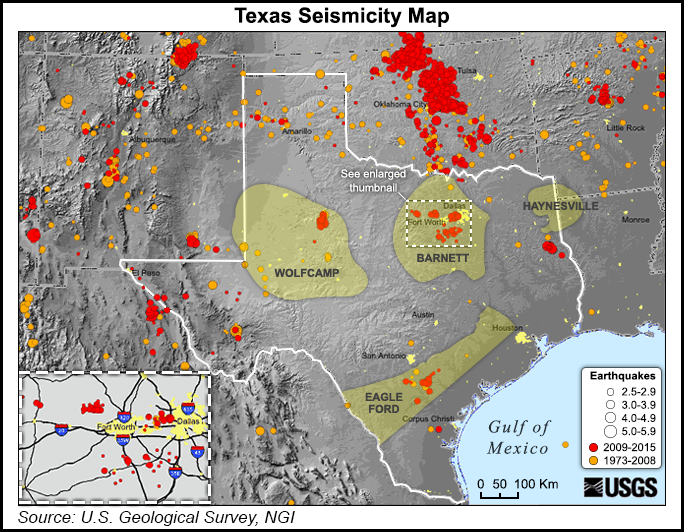Researchers: Injection, Extraction Wells ‘Likely’ Cause of Texas Quakes
Seismologists at Southern Methodist University (SMU) said Tuesday that high volumes of wastewater injection combined with saltwater extraction from natural gas wells is the “most likely cause” of earthquakes occurring near the Barnett Shale town of Azle, TX, from late 2013 through spring 2014.

For months, Azle area residents have complained of the ground shaking and damage to their homes (see Shale Daily, Jan. 21, 2014). Last summer in response, the Railroad Commission of Texas (RRC) began considering stricter regulation of waste injection wells (see Shale Daily, Aug. 13, 2014). Tougher rules were adopted last fall (see Shale Daily, Oct. 28, 2014).
Last January, RRC staff seismologist Craig Pearson, who was hired to investigate Texas quakes, wrote that the presumed injection well connection with seismic activity was over-hyped and not supported by his research or that done to date by SMU researchers (see Shale Daily, Jan. 16).
However, on Tuesday SMU researchers said they had identified two intersecting faults and developed a three-dimensional model to assess the changing fluid pressure within a rock formation in the affected area. They used the model to estimate stress changes induced in the area by two wastewater injection wells and the more than 70 production wells that remove both natural gas and significant volumes of salty water known as brine.
“The model shows that a pressure differential develops along one of the faults as a combined result of high fluid injection rates to the west and high water removal rates to the east,” said Matthew Hornbach, SMU associate professor of geophysics. “When we ran the model over a 10-year period through a wide range of parameters, it predicted pressure changes significant enough to trigger earthquakes on faults that are already stressed.” Model-predicted stress changes on the fault were typically tens to thousands of times larger than stress changes associated with water level fluctuations caused by the recent Texas drought, the research found.
“What we refer to as induced seismicity — earthquakes caused by something other than strictly natural forces — is often associated with subsurface pressure changes,” said Heather DeShon, SMU associate professor of geophysics. “We can rule out stress changes induced by local water table changes. While some uncertainties remain, it is unlikely that natural increases to tectonic stresses led to these events.”
DeShon said some ancient faults in the region are more susceptible to movement due to their orientation and direction. “In other words, surprisingly small changes in stress can reactivate certain faults in the region and cause earthquakes,” DeShon said.
The study, “Causal Factors for Seismicity near Azle, Texas,” has been published in the journal Nature Communications. It was produced by a team of scientists from SMU’s Department of Earth Sciences in Dedman College of Humanities and Sciences, the U.S. Geological Survey, the University of Texas Institute for Geophysics and the University of Texas Department of Petroleum and Geosystems Engineering.
“This report points to the need for even more study in connection with earthquakes in North Texas,” said Brian Stump, SMU Albritton chair in Earth Sciences. “Industry is an important source for key data, and the scope of the research needed to understand these earthquakes requires government support at multiple levels.”
SMU seismologists have been studying earthquakes in North Texas since 2008, when the first series of felt tremors hit near DFW International Airport between Oct. 30, 2008 and May 16, 2009. Next came a series of quakes in Cleburne between June 2009 and June 2010, and a third series in the Azle-Reno area northwest of Fort Worth occurred between November 2013 and January 2014.
The SMU researchers also are studying an ongoing series of earthquakes in the Irving-Dallas area that began in April 2014.
In both the DFW sequence and the Cleburne sequence, the operation of injection wells used in the disposal of natural gas production fluids was listed as a “possible” cause of the seismicity. The introduction of fluid pressure modeling of both industry activity and water table fluctuations in the Azle study represents the first of its kind, and has allowed the SMU team to move beyond assessment of “possible” causes to “the most likely“ cause identified in this report.
Prior to the DFW Airport earthquakes in 2008, an earthquake large enough to be felt had not been reported in the Fort Worth Basin since 1950. The North Texas earthquakes of the last seven years have all occurred in areas developed for natural gas extraction from the Barnett Shale. RRC reports that Barnett Production grew exponentially from 216 MMcf/d in 2000, to 4.4 Bcf/d in 2008, to a peak of 5.74 Bcf/d in 2012.
The area of study addressed in the report is in the Newark East Gas Field (NEGF), north and east of Azle. In this field, hydraulic fracturing is applied to loosen and extract gas trapped in the Barnett Shale. Wells in the Azle area of the NEGF can also bring to the surface significant volumes of water from the highly permeable Ellenburger Formation — both naturally occurring brine as well as fluids that were introduced during the fracking process.
© 2024 Natural Gas Intelligence. All rights reserved.
ISSN © 2577-9877 | ISSN © 1532-1266 | ISSN © 2158-8023 |
